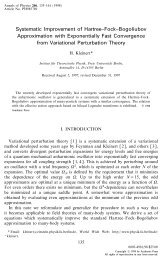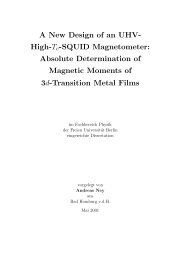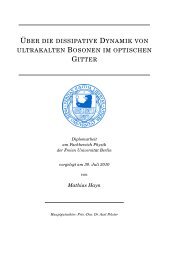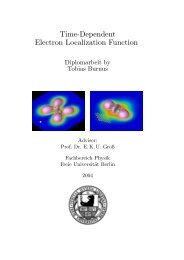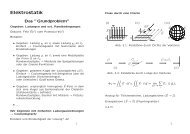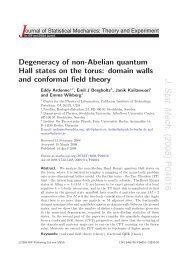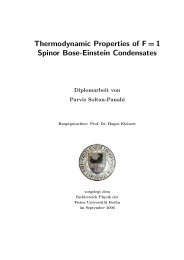Diploma thesis
Diploma thesis
Diploma thesis
You also want an ePaper? Increase the reach of your titles
YUMPU automatically turns print PDFs into web optimized ePapers that Google loves.
3 Complex square well potential<br />
ω → 0 at all as we can see by comparing with Figs. 3.2(b) – 3.2(k). So from this point of view<br />
both real and imaginary part do not show any tendency for ω → 0 to coincide with the calculated<br />
limit lim ω→0 ε k 0 = k 2 = m 2 at all. This looks inconsistent but at a later point of this discussion we<br />
will give an interpretation that provides an appropriate explanation of this.<br />
First we spend some time on looking at the particular strength of dissipation the maxima and<br />
minima of the imaginary part occur at. Let us call it c crit which seems to depend on the particular<br />
waist ω and state m we are considering. From Figs. 3.3(a) – 3.4(b) we can read off that c crit<br />
obviously increases for ω ≈ 0 with decreasing ω and for ω ≈ π with increasing ω, respectively.<br />
2<br />
Moreover, considering the symmetric states in Fig. 3.2(a) shows that the real part reaches its<br />
biggest slope at c crit that means it has an inflection point right there. A closer look on the<br />
antisymmetric states in Fig. 3.2(a) and on the n-states in Fig. 3.2(l) as well provides the same<br />
insight. So it seems that c crit denotes the dissipation, where the energy has its largest deviation<br />
from the limits we just discussed, that is for ε R being constant and for ε k I,0 as well as for ε n I,∞<br />
being equal to zero.<br />
Many things we have introduced and discussed so far can be generalized to arbitrary waists<br />
0 ≤ ω ≤ π , so we continue with the regime where all areas yield similar extensions.<br />
2<br />
3.2.2 Three areas regime<br />
Now let us take a look at the remaining pictures, that is the regime 0.1 ≤ ω ≤ 1.1, where both<br />
types of states are coexisting among the lowest six energy levels. First we can generalize the<br />
concept of c crit since ε k I,0 and ε n I,∞ + c reveal also in this case minima and maxima.<br />
Figure 3.5: ε k I,0 ≤ 0 (minima) and ε n I,∞ + c ≥ 0 (maxima) plotted for ω = 0.7.<br />
Considering Figs. 3.2(b) – 3.2(k) yields that for intermediate waists c crit also represents an inflection<br />
point of the real part of the energy, so its largest slope. Thus we can conclude that the critical<br />
dissipation exhibits the largest deviation from the limits ω 0 and ω π in the same way as we<br />
2<br />
found out in the end of the previous subsection.<br />
Since there occur only k-states for ω 0 and only n-states for ω π in the course of continuous<br />
2<br />
rearrangement a kind of continuous transfer of lower k-states with higher n-states for increasing<br />
16




